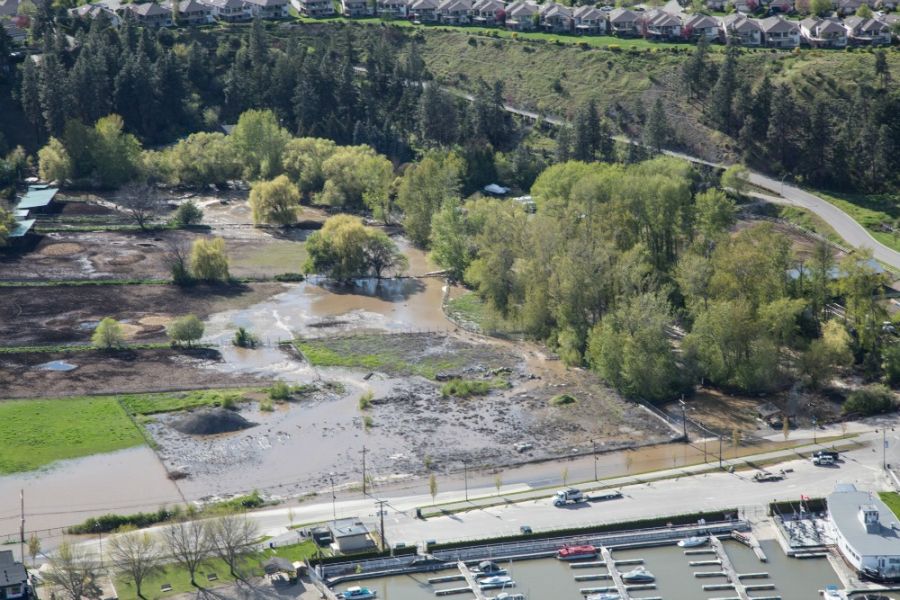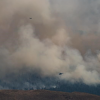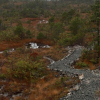If anything was learned from last year's flood season in Kelowna, it's preparation is key. But you can only prepare for what you're expecting. Last year's below-normal snowpack level and predicted drought led forecasters to believe an excess of water would be the last thing to expect. Much of the damage was done when early season rain started and didn't let up.

This year, Shaun Reimer, the gatekeeper of Okanagan Lake, is doing what he can to avoid last year's historic flood. Right now, he's draining Okanagan Lake at a maximum capacity of 60 cubic metres per second (60 m3/sec), the highest its run at this time of year in 10 years. He's been running the Penticton dam at that rate all week and prior to this week, he was draining the lake at a rate of 50 m3/sec.

"We have maximized our outflow at Penticton and that's at 60 cubic metres per second. That number is not the capacity of the dam. We could open up the dam much more than that and we would flood everyone out down south."
While it's not recommended, it happened last year in an attempt to get ahead of the steady inflow that resulted in historically high lake levels (rising to its peak of 343.251 metres on June 9, 2017).
"Last year we went up to 78 or 79 m3/sec. in Penticton, but that to me is an emergency flow. I am not going there not because I realize that causes issues—causes damage."
Besides flooding, the major concern of running the dam above max. capacity is the risk of bank erosion, which required repairs to multiple areas last year.

According to Reimer, last year, a section of the river north of Oliver dug into the dyke, threatening a church and a home, as well as several farms behind the dyke.
For now, Reimer will run the dam at a safe, but high capacity, he says.
"We are doing what we can for the conditions of the day and again this is still higher than we have ever seen before."
Right now, the main issue is the snowpack.
"We have a very high snowpack," said Reimer. "We can certainly see the snow has not declined in any way."

When the BC River Forecast Centre produces its next monthly snowpack report on Apr. 9, Reimer expects to see the snow basin index at the same level or even higher than it was for March 1, 2018, which was 141% of normal.
If the snowpack level hasn't dropped significantly, Reimer said he may start draining the lake above max capacity, starting as early as next week, but only as a last resource.

It was at this time last year the Valley was hit with unrelenting precipitation.
The following numbers show the amount of precipitation in Kelowna during the spring of 2017:
(Source: Wesla English, meteorologist).
Below shows the average amount of precipitation in Kelowna between 1981 and 2010:
-
March: 21.6 mm
-
April: 29.1 mm.
-
May: 40.2 mm.
In March 2018, Kelowna received about 21.9 mm of precipitation.
By mid-March this year, rain started to fall and mindful of last year's rain and this year's high snowpack, Reimer had the dam running at a high level.

According to Environment Canada, the Valley could see 10 days of rain going forward.
"These are the kinds of things that make us more aggressive in our water management."
Between Apr. 5 and Apr. 30, 2017, the lake levels rose 28 cms (from 341.836 metres to 342.119 metres).
By June 9, 2017, the lake hit its peak, rising to 343.251 m. After that, the lake levels started to either remain or drop.

That being said, the lake is currently about a metre below the full pool target of 342.48 metres. As of today, the level of Okanagan Lake is sitting at 341.484 m.
At this time last year (Apr. 6, 2017), Okanagan Lake was at 341.837 metres—35 centimetres higher than its current level.
So far, this season has experienced much lower lake and precipitation levels.

However, due to this year's above-average snowpack, Reimer will continue to operate the dam at a high rate until conditions change.
"The big precautionary measure is the drawdown of the lake and that's the big difference between this year and last year is that we can at least see it coming to a certain extent because of the high snowpack," he explained.
Reimer says he'll keep draining the lake at maximum capacity for a few more weeks, perhaps even beyond he says.

Reimer said lake levels started to rise with added precipitation in March, but have since levelled out. Looking ahead, the forecasted rain will play a role in how the dam is managed. According to Reimer, the immediate problem areas will be the ones that have already experienced localized flooding due to the rain in mid-March.

Over the weekend and into the following week, rain is expected almost every day, barring a break on Monday. Starting again on Tuesday, there's a 60% chance of rain and that trend will continue into Thursday of next week.
"I have maximized what I can do at this point," said Reimer.

If the flow gets too high for the channel in Penticton and Oliver, he may have to back off the outflow a little, to avoid potential flooding and erosion down south. But he's hopeful that won't happen for a few more weeks, if at all.
KelownaNow will continue following the snowpack, precipitation, lake and dam outflow levels as the season continues.
















